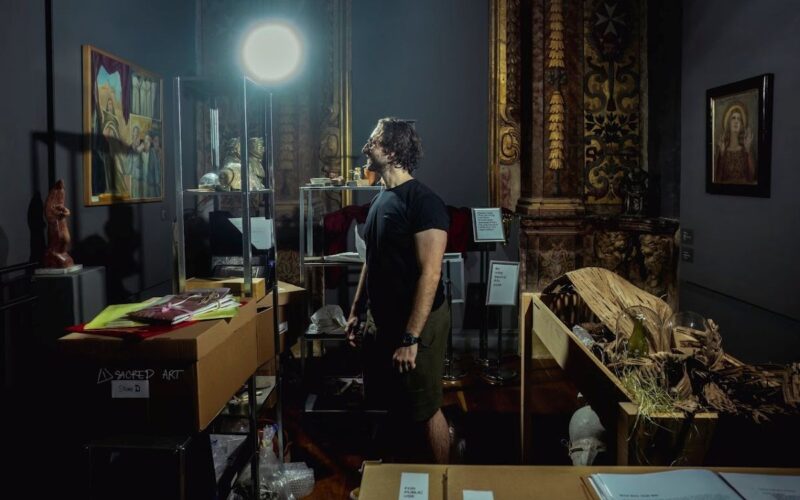The uncertainty of the contemporary world in which we live, where even a photographic image which once was taken as proof of reality but now does not guarantee truth, lies at the heart of Two Moons and Two Suns, currently on show at Malta Society of Arts in Valletta.

It’s a deep and thought-provoking exhibition addressing important ideas of doubt and mistrust. Rooted in recorded words and maps, and building feeling with olfactory and auditory elements, a group of artists from the Fictive Archive Investigations project subvert and question what we can really learn from archives. The documents they contain is used as a record of historical truth, yet have the details been stretched or spun, manipulated or biased by colonial attitudes, misogyny or other factors, or simply by poor memory? Which narratives are fictional? And, in a world where two suns can be seen clearly in specific climactic circumstances, could there sometime, or often, be two truths?
Entering the exhibition is akin to setting foot in an explorers’ base camp with maps on all sides. Centre-stage, a multitude of books is laid out on a giant table, an enticingly-colourful collection that draws you in. These include books on Malta, from geology to the traditional buses and novels set on islands including Robinson Crusoe and Lord of The Flies which include some real truths even if the characters are invented. With other titles including Brook-Hitching’s The Phantom Atlas and Tallack’s The Un-Discovered Islands, I could have whiled away a happy weekend here if there’d been an easy-chair to settle into.

The exhibition is structured as if each room is a new chapter in a travel guide, and it’s an engaging approach. Voyagers are encouraged to take a bookmark loaded with a scent created for this project to accompany them on their road-trip, and because visitor also hear the soundtracks of installations further on, it’s a multi-sensory experience.

The following room focuses on cartographic fragments, with eighteen monotypes of open books presented on six wall-to-ceiling scrolls, perhaps a nod to ancient papyrus and its contribution to our knowledge of ancient history. One captivating exhibit here, by Matthew Schembri, is a series of large postcards depicting islands around the world, some popularly visited, others less so. The coastline of each is drawn using the lines of a poem from their native language: the letters or script are hard to decipher, a reminder of the laborious process required to interpret fragmented archival material. “And what truths can we learn from national poetry?” I ponder.
Unstable Nostalgia is Two Moons and Two Suns’ next staging post. It presents ‘another reality’ – ‘that of the world seen for the first time; through sharp unjaded eyes.’ Here Céline Cuvelier’s works focus on tourism and the mirage of paradise found in a holiday brochure. With a bikini constructed from the packets of pharmaceutical products, for example, she appears to ask whether these vacation destinations are really as promised.

Alongside, a series of museum cases contain small found objects, the remnants of walks taken by artist Raffaella Zammit and her son Tumas. They’re a summary of a childhood where curiosity is encouraged, and with a touch of humour, one case contains only a note, “No walk – sometimes plans go unplanned.” It’s the prefect reminder that the details of an event in an archive may outline an occurrence that never happened.
The journey continues with an excursion into Ocean Poetry in which Katel Delia’s airy photographic prints on thin fabric show the sea where it meets the land. These sway gently like the shifting sands of the edge of the island evoking the idea that the intangible boundaries of archival truth. Whilst set to music, this is overridden by the soundtrack of the neighbouring installation, an old woman’s story ‘born in the memories of a lifetime seasoned by dreaming of the Middle Sea,’ highlighting the interesting issue of overlapping and jostling narratives in archival material.

A compulsion to search for Phantom Islands, and an old misconception that California was an island, drives Stéphanie Roland’s works as the show’s narratives leads on, before visitors are invited into the reproduction of a small island archive – that of Malta’s mysterious Farfara. It’s an installation that’s excitingly ‘behind the scenes in the museum.’ However, the light dims after ten seconds or so, however many times you step back and forth into the space, presumably representing the way the enlightenment found in old documents and cabinets comes in short bursts amidst the dark of the unknown and the uncertain. And, finding myself in the shoes of a researcher, I’d have loved to be able to investigate more easily. This feeling carried over too into a work incorporating augmented reality in the Palazzo’s courtyard, and the promise of an object-blending reconstruction remembering one of Malta’s most revered historical architects.
Two Moons and Two Suns runs at Malta Society of Arts, Valletta until August 20










